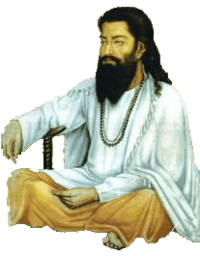Ad-Dharmi
| Part of a series on the |
| Ravidassia religion |
|---|
 |
| Beliefs and practices |
| Temples |
| Scriptures |
| Holy Places |
| Founder |
| Festivals |
| Symbols |
 |
The Ad-Dharmi (Punjabi: ਆਦਿ ਧਰਮੀ) is a former-untouchable, Dalit Scheduled Caste community and now a Chamar Sub-caste[1] found in the state of Punjab in India.[2] As of today they are entitled to reservations in Education sector and government jobs as they are recognised as Scheduled Caste.[3] Ad Dharmis are 14.9% of the total Dalit population in Punjab.[4]
Origin
The Ad-dharmi movement was started in 1920's, for the purpose of getting a distinct religious identity. The founder of the ad-dharmi movement was Mangu Ram Mugowalia and B L Gherra.[5] The movement projected Ravidas as their spiritual Guru and a sacred book Ad Parkash for separate ritual traditions. The Ad-dharmi Dalits came together as a faith was in 1925 when the British ruled India. In the 1931 census, more than 450,000 registered themselves as members of the new Dalit faith called Ad Dharam (or Original Religion).[6] But this faith and movement vanished after India's independence mainly because of lures of government jobs reserved for low-caste Sikhs and Buddhists.[7] The Ad-Dharmi are further divided into a number of exogamous clans, the main ones being the Bangur, Bhardwaj, Bhargu, Chakhu, Chokhria, Chandar, Choudhary, Heer, Hohe, Kainth, Mal, Mahey, Mahi, Por, Ralh, Rattu, Rai, Sandhu, Sheemar, Soniara, Sund, Sidhu, Shergill and Thind and Pharias community.
Present circumstances
Although the Ad-Dharmi are followers of Guru Ravidas (now Ravidassia religion),[8] and incorporate elements of Sikhism[9] as they regard Shri Guru Granth Sahib as their religious text.[10] Each of their settlement contains a gurdwaras and Ravidas Bhawans, which are both a centre of worship and as well as a focus of the community.
The traditional occupation of the Ad-Dharmis was leather tanning although a majority were agricultural labourers. There has greater upward mobility among groups in Punjab then other parts of India. As such, many Ad-Dharmis have started to migrate to towns and cities, where they have taken on a number of blue and white collar professions. A small but significant minority have also taken to education. Like other Punjabis, the Ad-Dharmis have participated in the overseas migration of the ethnic group. There are now fairly large Ad-Dharmis communities in Europe and North America, in particular the United Kingdom.[11]
See also
References
- ↑ Kumar, Ashutosh. The Chamar caste group includes Ad-Dharmi, Jatia Chamar, Rehgar, Raigar, Ramdasias and Ravidasias. -Rethinking State Politics in India: Regions Within Regions. p. 387.
- ↑ "Deras and Dalit Consciousness". Mainstream Weekly. 13 June 2009. Retrieved 6 January 2016.
- ↑ "Scheduled Caste Welfare - List of Scheduled Castes" (PDF).
- ↑ "PUNJAB DATA HIGHLIGHTS : THE SCHEDULED CASTES" (PDF).
- ↑ pg 20, Sikh Identity: An Exploration Of Groups Among Sikhs by Opinderjit Kaur Takhar
- ↑ "India's 'untouchables' declare own religion". CNN.com. Retrieved 6 January 2016.
- ↑ Gill, Manmohan Singh (December 2, 2015). "Punjab Society". Google Books. Retrieved January 6, 2016.
- ↑ "Mention Ravidasia as religion: Dera Sachkhand to followers". Indian Express. Retrieved 6 January 2016.
- ↑ "Like the other Sikh gurudwaras, Ad-Dharmis too keep the Guru Granth Sahib at their Ravidas Gurudwaras- Caste in Question". Google Books. December 2, 2015. Retrieved January 6, 2016.
- ↑ Singh, IP (4 February 2010). "Ravidassia leaders reject new religion". The Times of India. Retrieved 6 January 2016.
- ↑ People of India Punjab Volume XXXVII edited by I.J.S Bansal and Swaran Singh pages 20 to 25 Manohar